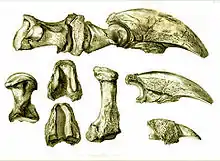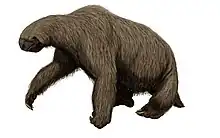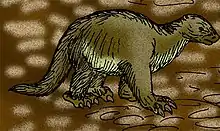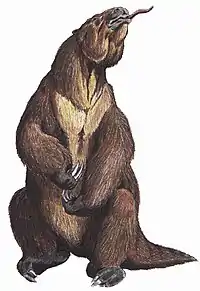| Megalonyx | |
|---|---|
 | |
| M. wheatleyi skeleton in AMNH | |
| Scientific classification | |
| Domain: | Eukaryota |
| Kingdom: | Animalia |
| Phylum: | Chordata |
| Class: | Mammalia |
| Order: | Pilosa |
| Family: | †Megalonychidae |
| Subfamily: | †Megalonychinae |
| Genus: | †Megalonyx Disputed, see text |
| Type species | |
| †Megalonyx jeffersonii Desmarest 1822 | |
| Species | |
Megalonyx (Greek, "great-claw") is an extinct genus of ground sloths of the family Megalonychidae, native to North America. It evolved during the Pliocene Epoch and became extinct during the Quaternary extinction event at the end of the Late Pleistocene-Early Holocene, living from ~5 million to ~13,000 years ago.[2] The type species, M. jeffersonii (also called Jefferson's ground sloth), the youngest and largest known species, measured about 3 meters (9.8 ft) in length and weighed up to 1,000 kilograms (2,200 lb).[3]
Megalonyx was descended from Pliometanastes, a genus of ground sloth that had arrived in North America during the Late Miocene around 9 million years ago, prior to the main phase of the Great American Interchange. Megalonyx had the widest distribution of any North American ground sloth, having a range encompassing most of the contiguous United States, extending as far north as Alaska during warm periods.
Taxonomy

In 1796, Colonel John Stuart sent Thomas Jefferson, shortly before he took office as Vice President of the United States, some fossil bones: a femur fragment, ulna, radius, and foot bones including three large claws. The discoveries were made in a cave in Greenbrier County, Virginia (presently West Virginia). Jefferson examined the bones and presented his observations in the paper "A Memoir on the Discovery of Certain Bones of a Quadruped of the Clawed Kind in the Western Parts of Virginia" to the American Philosophical Society in Philadelphia on March 10, 1797.[4] The paper was published in 1799, in the same volume as an accompanying paper by his colleague Caspar Wistar, who provided detailed anatomical information about the bones, and illustrated them.[5] Together these two papers are considered the first North American publications devoted to paleontology.
In the 1799 paper, Jefferson named the then-unknown animal Megalonyx ("great-claw") and compared each recovered bone to the corresponding bone in a lion.[6] In his original draft of the paper, Jefferson thought the animal was a carnivore, one of the large cats, writing “Let us only say then, what we may safely say, that he was more than three times as large as the lion”. In a postscript, composed after learning of Baron Georges Cuvier's description and illustration of the giant ground sloth Megatherium, discovered in Argentina (mistakenly referred to as Paraguay), Jefferson revised his interpretation and compared Megalonyx to Megatherium.
Contrary to Baron Cuvier's view that extinction had played an important role in natural history, an idea that would reach scientific consensus decades later, Jefferson wrote about a "completeness of nature" whose inherent balance did not allow species to go extinct naturally. He asked Lewis and Clark, as they planned their famous expedition in 1804–1806, to keep an eye out for living specimens of Megalonyx, as this would support his case. His idea made no headway and was later shown to be incorrect.[7] However, Jefferson's notion that humans and Megalonyx co-existed in North America has been shown to be correct, as some bones of Megalonyx show marks made by flint tools.[8]
His presentation to the American Philosophical Society in 1797 is often credited as the beginning of vertebrate paleontology in North America. In 1799, Caspar Wistar correctly identified the remains as those of a giant ground sloth. In 1822, Desmarest named the species Megalonyx jeffersonii in honor of the former statesman and scientist. Richard Harlan in 1825 provided additional taxonomic description of Megalonyx.[9] Scientific papers variously give the authority for the genus as Jefferson 1799 (after Jefferson's original naming of the genus),[10] or Harlan 1825.[11]
Recent research confirms that the sloth bones were discovered in Haynes Cave in Monroe County, West Virginia. For many decades in the twentieth century, the reported origin of Jefferson's "Certain Bones" was Organ Cave in what is now Greenbrier County, West Virginia. This story was popularized in the 1920s by a local man, Andrew Price of Marlinton.[12] The story came under scrutiny when in 1993 two fragments of a Megalonyx scapula were found in Haynes Cave in neighboring Monroe County. Smithsonian paleontologist Frederick Grady presented evidence in 1995 confirming Haynes Cave as the original source of Jefferson's fossil.[13]
Jefferson reported that the bones had been found by saltpeter workers. He gave the cave owner's name as Frederic Crower. Correspondence between Jefferson and Colonel Stuart, who sent him the bones, indicates that the cave was located about five miles from Stuart's home and that it contained saltpeter vats. An investigation of property ownership records revealed "Frederic Crower" to be an apparent misspelling of the name Frederic Gromer.[13]
Organ Cave was never owned by Gromer, but Haynes Cave was. Two letters written by Tristram Patton, the subsequent owner of Haynes Cave, indicate that this cave was located in Monroe County near Second Creek. Monroe County had originally been part of Greenbrier County; it became a separate county shortly after the discovery of the bones. In his own letters Patton described the cave and indicated that more fossil bones remained inside.[13]
M. jeffersonii is still the most commonly identified species of Megalonyx. It was designated the state fossil of West Virginia in 2008.
M. leptostomus, named by Cope (1893), lived from the Blancan to the Irvingtonian. This species lived from Florida to Texas, north to Kansas and Nebraska, and west to New Mexico, Nevada, Oregon, and Washington. It is about half the size of M. jeffersonii. It evolved into M. wheatleyi, the direct ancestor of M. jeffersonii. Species gradually got larger, with different species mostly based on size and geologic age.
Evolution
The first wave of Megalonychids came to North America by island-hopping across the Central American Seaway from South America, where ground sloths arose, prior to formation of the Panamanian land bridge. Based on molecular results, its closest living relatives are the three-toed sloths (Bradypus); earlier morphological investigations came to a different conclusion.[14][15] Megalonyx is thought to be descended from Pliometanastes, a ground sloth that arrived in North America during the late Miocene, around 9 million years ago.[16][17]
The earliest representatives of Megalonyx appeared during the Pliocene.[17] M. jeffersonii lived from the late Middle Pleistocene/ late Irvingtonian (250–300,000 years ago)[11] through to the Rancholabrean of the Late Pleistocene (11,000 BP[18]). M. jeffersonii was probably descended from M. wheatleyi.[19] The Megalonyx lineage increased in size with time, with the last species M. jeffersonii being the largest.[11]
Description

Megalonyx jeffersonii was a large, heavily built herbivore about 3 m (9.8 ft) long.[3] It was comparable in size to a cow, with some specimens estimated to exceed 1,000 kg (2,200 lb) in mass.[11] The hind limbs were plantigrade (flat-footed) and this, along with its stout tail, allowed it to rear up into a semi-erect position to feed.[11] The hands had three large claws, which were likely used for grasping and defense.[3] The teeth of Megalonyx jeffersonii were hypselodont (high crowned).[11]
Paleobiology
During excavations at Tarkio Valley in southwest Iowa, an adult (presumably female) Megalonyx jeffersonii was found in direct association with two juveniles of different ages, the oldest suggested to be around 3-4 years old, suggesting that adults cared for young of different generations.[20][21][11] A 2022 study estimated, based on the ages of the adult and the two juveniles, that the average lifespan was approximately 19 years, sexual maturity occurred at about 6 and a half years, that gestation time was around 14 months, and the interval between births was approximately 3 years.[11] Megalonyx is thought to have been a browser.[11]
Habitat
Megalonyx jeffersonii ranged over much of North America, with its range spanning nearly the whole contiguous United States and parts of southern Canada, with some remains known as far south as central Mexico.[11] Their remains have been found as far north as Alaska[22] and the Yukon during interglacial intervals.[23]
In 2010, a specimen was discovered at the Ziegler Reservoir site near Snowmass Village, Colorado, in the Rocky Mountains at an elevation of 8,874 feet (2,705 m).[24] The habitat of Megalonyx jeffersonii was highly variable, but often associated with spruce-dominated, mixed conifer-hardwood forest.[11]
Extinction
.jpg.webp)
Megalonyx jeffersonii became extinct at the end of the Pleistocene, as part of the Quaternary extinction event, in which all other mainland ground sloths and most other large mammals of the Americas became extinct.[11] The youngest confirmed radiocarbon date is in Ohio, dating to 13,180–13,034 calibrated years Before Present.[2] This timing was co-incident with both the Younger Dryas and a major growth in population of recently arrived Paleoindians. In Ohio, a specimen of Megalonyx jeffersonii, dubbed the "Firelands Ground Sloth", dating to around 13,738 to 13,435 calibrated years Before Present (~11,788 to 11,485 BCE) was found with cut marks indicative of butchery, suggesting that hunting may have played a role in its extinction.[8]
See also
- Paramylodon a mylodontid ground sloth native to North America during the Pliocene and Pleistocene
- Nothrotheriops a nothrotheriid ground sloth native to North America during the Pleistocene
References
Citations
- ↑ Megalonyx obtusidens at Fossilworks.org
- 1 2 McDonald, H. Gregory; Stafford, Thomas W.; Gnidovec, Dale M. (March 2015). "Youngest Radiocarbon Age for Jefferson's Ground Sloth, Megalonyx Jeffersonii (Xenarthra, Megalonychidae)". Quaternary Research. 83 (2): 355–359. Bibcode:2015QuRes..83..355G. doi:10.1016/j.yqres.2014.11.006. S2CID 129016865. Retrieved 2021-05-23.
- 1 2 3 "Sandiegozoo". Archived from the original on 2015-02-14. Retrieved 2012-05-30.
- ↑ Jefferson, Thomas, "A Memoir on the Discovery of Certain Bones of a Quadruped of the Clawed Kind in the Western Parts of Virginia", Read before the American Philosophical Society, March 10, 1797.
- ↑ Wistar, Caspar (1799), "A Description of the Bones Deposited, by the President, in the Museum of the Society, and Represented in the Annexed Plates", Transactions, pp. 526-531, plates.
- ↑ Jefferson, Thomas, "A Memoir on the Discovery of Certain Bones of a Quadruped of the Clawed Kind in the Western Parts of Virginia", Read before the American Philosophical Society, March 10, 1797.
- ↑ Rowland, Steve, "The Fossil Record", Published lecture notes for "The Fossil Record" course at the University of Nevada, Las Vegas, August 2010
- 1 2 Redmond, Brian G.; McDonald, H Gregory; Greenfield, Haskel J.; Burr, Matthew L. (March 2012). "New evidence for Late Pleistocene human exploitation of Jefferson's Ground Sloth (Megalonyx jeffersonii) from northern Ohio, USA". World Archaeology. 44 (1): 75–101. doi:10.1080/00438243.2012.647576. ISSN 0043-8243. S2CID 161436888.
- ↑ McKenna, M.C.; Bell, S.K. (1997). Classification of Mammals: Above the Species Level. Columbia University Press. p. 100. ISBN 0-231-11013-8.
- ↑ Amson, Eli; Argot, Christine; McDonald, H. Gregory; de Muizon, Christian (June 2015). "Osteology and Functional Morphology of the Forelimb of the Marine Sloth Thalassocnus (Mammalia, Tardigrada)" (PDF). Journal of Mammalian Evolution. 22 (2): 169–242. doi:10.1007/s10914-014-9268-3. ISSN 1064-7554. S2CID 17876664.
- 1 2 3 4 5 6 7 8 9 10 11 12 Semken, Holmes A.; McDonald, H. Gregory; Graham, Russell W.; Adrain, Tiffany; Artz, Joe Alan; Baker, Richard G.; Bryk, Alexander B.; Brenzel, David J.; Arthur Bettis, E.; Clack, Andrew A.; Grimm, Brittany L.; Haj, Adel; Horgen, Sarah E.; Mahoney, Meghann C.; Ray, Harold A. (30 June 2022). "Paleobiology of Jefferson's Ground Sloth ( Megalonyx jeffersonii ) derived from three contemporaneous, ontogenetically distinct individuals recovered from Southwestern Iowa, U.S.A." Journal of Vertebrate Paleontology. 42 (1): e2124115. Bibcode:2022JVPal..42E4115S. doi:10.1080/02724634.2022.2124115. ISSN 0272-4634. S2CID 253258474.
- ↑ Humphreys, Blanche (1928), History of Organ Cave Community (Greenbrier County, West Virginia); Agricultural Extension Division.
- 1 2 3 Grady, Fred (1995), "The Search for the Cave from which Thomas Jefferson Described the Bones of the Megalonyx" [Abstract], In: "Selected Abstracts from the 1995 National Speleological Society National Convention in Blacksburg, Virginia"; In: Journal of Cave and Karst Studies, April 1997, pg 57.
- ↑ Presslee, S.; Slater, G.J.; Pujos, F.; Forasiepi, A.M.; Fischer, R.; Molloy, K.; Mackie, M.; Olsen, J.V.; Kramarz, A.; Taglioretti, M.; Scaglia, F.; Lezcano, M.; Lanata, J.L.; Southon, J.; Feranec, R.; Bloch, J.; Hajduk, A.; Martin, F.M.; Gismondi, R. S.; Reguero, M.; de Muizon, C.; Greenwood, A.; Chait, B.T.; Penkman, K.; Collins, M.; MacPhee, R.D.E. (2019). "Palaeoproteomics resolves sloth relationships" (PDF). Nature Ecology & Evolution. 3 (7): 1121–1130. Bibcode:2019NatEE...3.1121P. doi:10.1038/s41559-019-0909-z. PMID 31171860. S2CID 174813630.
- ↑ Delsuc, F.; Kuch, M.; Gibb, G.C.; Karpinski, E.; Hackenberger, D.; Szpak, P.; Martínez, J.G.; Mead, J.I.; McDonald, H.G.; MacPhee, R.D.E.; Billet, G.; Hautier, L.; Poinar, H.N. (2019). "Ancient Mitogenomes Reveal the Evolutionary History and Biogeography of Sloths". Current Biology. 29 (12): 2031–2042.e6. doi:10.1016/j.cub.2019.05.043. hdl:11336/136908. PMID 31178321.
- ↑ Tedford, R.H.; Albright, L.B.; Barnosky, A.D.; Ferrusquaia-Villafranca, I.; Hunt, R.M.; Storer, J.E.; Swisher, C.C.; Voorhies, M.R.; Webb, S.D.; Whistler, D.P. (21 April 2004). "Mammalian Biochronology of the Arikareean Through Hemiphilian Interval (Late Oligocene Through Early Pliocene Epochs)". In Woodburne, M.O. (ed.). Late Cretaceous and Cenozoic Mammals of North America: Biostratigraphy and Geochronology. Columbia University Press. pp. 169–231, see also p. 337. ISBN 978-0231503785. OCLC 880404891.
- 1 2 McDonald, H.G.; Morgan, G.S. (2011). "Ground sloths of New Mexico". New Mexico Mus Nat. Hist. Sci. Bull. 53: 652–663.
- ↑ Fiedal, Stuart (2009). "Sudden Deaths: The Chronology of Terminal Pleistocene Megafaunal Extinction". In Haynes, Gary (ed.). American Megafaunal Extinctions at the End of the Pleistocene. Vertebrate Paleobiology and Paleoanthropology. Springer. pp. 21–37. doi:10.1007/978-1-4020-8793-6_2. ISBN 978-1-4020-8792-9.
- ↑ Schubert, Blaine W.; Mead, Jim I.; Graham, Russell W., eds. (2003). "Sloth remains from North American caves and associated karst features". Ice Age cave faunas of North America. Indiana University Press. ISBN 0-253-34268-6. OCLC 50803740.
- ↑ "The Tarkio Valley Sloth Project · Project Summary". Archived from the original on 2009-01-01. Retrieved 2009-09-25.
- ↑ Semken, Holmes; Brenzel, David (Spring 2007). "One Sloth Becomes Three". Newsletter of the Iowa Archeological Society. Vol. 57, no. 1. pp. 1–2.
- ↑ Stock, C. (29 May 1942). "A ground sloth in Alaska". Science. AAAS. 95 (2474): 552–553. Bibcode:1942Sci....95..552S. doi:10.1126/science.95.2474.552. PMID 17790868.
- ↑ McDonald, H. G.; Harington, C. R.; De Iuliis, G. (September 2000). "The Ground Sloth Megalonyx from Pleistocene Deposits of the Old Crow Basin, Yukon, Canada" (PDF). Arctic. Calgary, Alberta: Arctic Institute of North America. 53 (3): 213–220. doi:10.14430/arctic852. Retrieved 2008-08-16.
- ↑ "Snowmass tally: 10 mastodons, 4 mammoths, one "once-in-a-lifetime" find". The Denver Post. 18 November 2010.
Other sources
- Cope, ED. (1871) Preliminary report on the vertebrata discovered in the Port Kennedy Bone Cave. American Philosophical Society, 12:73-102.
- Cope, ED. (1893) A preliminary report on the vertebrate paleontology of the Llano Estacado. 4th Annual Report on the Geological Survey of Texas: 136pp.
- Hirschfeld, SE. and SD. Webb (1968) Plio-Pleistocene megalonychid sloths of North America. Bulletin of the Florida State Museum Biological Sciences, 12(5):213-296.

